Have you got a vine weed growing in your yard?
The following list is some of the most common types of vine weeds. We’ll help you identify the weed using photos and descriptions.
Let’s dive in.
Morning Glory Vine (Ipomoea)
The name morning glory refers to a number of closely related plants, many of which are summer annual broadleaf vines. Morning glory spreads through seeds and regrows each year but reseeds so successfully that you probably won’t notice.
The plant is well-known for its trumpet-shaped flowers that grow in clusters of 2-5 and come in many colors. You can find morning glory vines with white flowers, purple flowers, pink flowers, blue flowers, red flowers, orange flowers, and sometimes bi-colored flowers. The flowers bloom from June to November.
The leaves grow alternately along the vine and are usually heart-shaped. The leaves grow 3-5 inches long and are sometimes glossy.
Morning glory vines rapidly spread in hot weather. A mature plant can quickly grow vines 15 ft. tall, with the stems twisting around each other to strengthen and support the plant’s growth.
Some people like to plant morning glory as a groundcover or aesthetic enhancement for fences and barriers. But because it grows fast, morning glory can quickly become an invasive vine, spreading into yards nearby, growing over all surfaces, and harming plants.
Once established, morning glory can be very hard to get rid of, often requiring the use of powerful chemicals to kill the weed.
Field Bindweed (Convolvulus arvensis)
Field Bindweed is sometimes called morning glory because it has similar-looking trumpet-shaped flowers that can be white, light pink, or sometimes both.
Field bindweed is a perennial broadleaf weed. This invasive vine weed is an aggressive grower that quickly develops slender stems up to 6 ft. long, climbing over trees, walls, fences, and along the ground.
The plant has smooth, arrowhead-shaped leaves connected to the stem by petioles. Mature leaves near the beginning of the stem are larger than the leaves at the end of the stem.
Field bindweed spreads by rhizomes, stems, and roots, and produces seeds that remain viable in the soil for 20 years or more. Once the vine weed becomes established, it’s very difficult to get rid of. And it quickly outcompetes plant species growing in the invaded area.
Field bindweed is a common farm weed that can be a major problem when it invades agricultural land as it can reduce yields by up to 60% (1).
The vine grows in a variety of conditions, in full shade and full sun, and is drought tolerant. You’ll often see field bindweed growing in farmland, forested parks, greenbelts, ravines, and gardens.
Trumpet Creeper (Campsis radicans)
Trumpet creeper is also called cow-itch vine and trumpet vine. This aggressive woody perennial vine is a multi-stemmed, dense-growing weed that produces long stems that can reach 30 ft. or more, climbing up structures with the help of its aerial rootlets.
The vine weed is known for its showy reddish-orange flowers. The flowers are trumpet-shaped, hence the plant name, and grow 2-3 inches long in clusters at the end of the stems.
The pinnately compound leaves grow oppositely, have a long point, and are coarsely toothed. Each leaf consists of 7-15 lance-shaped leaflets that grow from 1-3 inches long.
Be careful about touching trumpet creeper because it can cause a skin rash.
Common places to find trumpet creeper growing include roadsides, fence rows, woods, hayfields, and pastures.
Poison Ivy (Toxicodendron radicans)
Poison ivy is a noxious weed that grows as a groundcover, a shrub, or a climbing vine weed. Poison ivy is well-known for the uncomfortable rash that develops after you touch it, so be careful if you find this vine weed in your grass. The rash is caused by an oily resin called urushiol that’s present in the leaves, stems, and roots, so wear gloves when handling the plant.
You can identify poison ivy by its compound leaves consisting of 3 leaflets. The leaves grow alternately from a stem that’s sometimes tinged red. The leaves on young poison ivy plants are often reddish in the spring before turning shiny green. The leaves change to dull green in the summer and then turn yellow or scarlet in the fall.
Poison ivy is a perennial that loses its leaves in the winter, but the hairy vines remain. The weed regrows the leaves in the spring.
Poison ivy is an unpleasant weed to find growing in your yard. It grows in various soil conditions, thriving in moist and very dry soil. And it grows in partial shade to full sun, sending out vines that can sometimes reach 100 ft. long.
Virginia Creeper (Parthenocissus quinquefolia)
Virginia creeper is a fast-growing perennial woody vine that you’re most likely to see growing in gardens, vineyards, orchards, and even across your lawn. People sometimes misidentify Virginia creeper as poison ivy, but Virginia creeper has compound leaves with 5 leaflets. Each leaflet also tapers to appoint and has toothed edges.
Virginia creeper doesn’t produce the skin irritant urushiol that’s found in poison ivy, but it does have a sap that causes a rash for sensitive people.
Virginia creeper is an adaptable plant that grows well in full sun or full shade and tolerates dry or soggy soil. The vine can grow up to 30 ft. high, scaling obstacles and climbing walls with the help of adhesive pads at the end of its tendrils.
From June to July, Virginia creeper blooms with clusters of small, greenish-yellow flowers. When the flowers fade, they are replaced by poisonous dark blue-black berries that grow from red stems.
Bittersweet Nightshade (Solanum dulcamara)
Also known as poison berry, bitter nightshade, blue bindweed, and climbing nightshade, bitter nightshade is a perennial woody vine that climbs and grows along the ground, reaching up to 10 ft in length. The weed is notorious for its toxicity, with all parts of the plant poisonous.
Bittersweet nightshade has dark green, ovate leaves, that can be purple-tinged. The leaves grow alternately from stiff, smooth stems that are purple to greenish-brown, reaching 2-4 inches long. The plant blooms from May to September, with small flowers that grow in clusters. The flowers have bright purple petals with yellow anthers. In the fall, you’ll see hanging clusters of bright red berries.
It’s common to see bittersweet nightshade growing in gardens, parks, along roadsides, and around field edges and wetlands. The plant likes moist, loamy soil, and full sun to partial shade. In the right conditions, it spreads rapidly through rhizomes and seeds, particularly in areas of disturbed soil.
Honeyvine Milkweed (Ampelamus albidus)
Honeyvine milkweed vine is also called climbing milkweed, dog’s wort, bluevine, and sandvine. It’s a perennial vine that grows fast, often increasing length up to 12 ft. during a growing season.
The stems are slender, hairless, and intertwine as they grow along the ground or climb. Heart-shaped leaves grow oppositely from the stems on petioles. The leaves have white veins and grow 3-7 inches long and 1.5-5 inches wide. Small white flowers with 5 petals grow in clusters. The plant produces large, green seedpods 3-6 inches long.
Some people incorrectly identify honeyvine milkweed as field bindweed or morning glory because of the leaf shape. But the white veins on the leaves and the difference in the flowers make it easy to distinguish from other types of vine weeds.
Like many other weeds, honeyvine milkweed spreads by seeds and rhizomes and can grow in most soil types. It’s common to find this vine weed in urban areas in gardens and along fence rows, as well as woodland edges and cultivated fields.
Common Greenbrier (Smilax rotundifolia)
COMMON GREENBRIER BY FRANKLIN BONNER, USFS (RET.), BUGWOOD.ORG, CC BY 3.0, VIA WIKIMEDIA COMMONS
Common greenbrier is also known as catbrier or roundleaf greenbrier. Common greenbrier is native to Eastern and South-Eastern North America, and you’ll usually see it growing in woods and forests.
This weed is identifiable by its long woody vines with large black-tipped thorns. The vines grow up to 25 feet long, are hard like canes, and are pale green in color. The vines grow over the ground and climb over objects and vegetation with the help of small tendrils.
COMMON GREENBRIER BY JUDY GALLAGHER
The leaves are green, glossy, and oval-shaped, growing from the stems on petioles. Depending on the location, the plant flowers sometime from April to June, producing greenish-white flowers that grow in clusters of 3-20 flowers. In the fall, bluish-black berries grow in loose bunches and stay throughout the winter, often lasting until spring.
Mile-A-Minute (Persicaria perfoliata)
PERSICARIA PERFOLIATA BY KATJA SCHULZ
Mile-a-minute is also called Asiatic tearthumb, giant climbing tearthumb, and devil’s tail. Originally from East Asia and India, mile-a-minute was introduced to North America in the 19th century and is now an invasive and noxious vine weed in many states. The plant is an herbaceous annual vine that dies each fall and regrows each year from seeds that germinate in the spring.
True to its name, mile-a-minute grows fast, adding an extra 6-inches of growth a day at its peak until reaching its full size, usually somewhere from 20-30 ft. The vines intertwine to form a dense blanket.
The green to reddish colored stems are prickly with sharp thorns, so be careful when handling this viney weed. Light green, triangular leaves grow alternately from the stem. Small white flowers grow in special cup-shaped leaves growing at intervals from the vine stems. The flowers eventually give way to blue berries that start off green.
Mile-a-minute thrives in full sunlight, and the thorns on its stems help the vine clamber over other plants and man-made obstacles to reach a brighter location. The plant also likes a high soil moisture content and often colonizes wetlands, streambanks, forest edges, and roadsides.
Bushkiller Vine (Cayratia japonica)
Bushkiller is a perennial vine that’s native to Asia and Australia but is now present as an invasive weed in some states in the US.
Bushkiller vine has compound leaves that consist of 5 leaflets, which sometimes leads to people misidentifying the plant as Virginia creeper (2). One way to tell the difference is that the central leaflet doesn’t have its own stem on Virginia creeper.
Orange or salmon-colored flowers are visible in late summer. The flowers are small and develop in clusters.
CAYRATIA JAPONICA BY PHONON.B, CC BY 4.0, VIA WIKIMEDIA COMMONS
Bushkiller climbs nearby structures and trees, producing dense foliage that can block sunlight to nearby plants. The vine weed also competes with desirable plants for nutrients and water from the soil, reducing their growth.
Common places to find bushkiller vine growing are disturbed ground in residential areas, fallow fields, harvested forests, and overgrazed pastures.
Black Swallow Wort (Cynanchum louiseae)
BLACK SWALLOW_WORT BY PHILIPPE GERBET, CC BY-SA 4.0, VIA WIKIMEDIA COMMONS
Black swallow-wort is also called dog-strangling vine. Black swallow-wort is a perennial vine that’s native to Europe but was introduced to the United States as an ornamental in the 19th century, subsequently escaping from gardens and spreading as a weed (3).
Black swallow-wort is very fast growing and is allelopathic, producing chemicals that inhibit the growth of nearby plants. It quickly takes over areas, choking out and displacing native plant species and affecting local biodiversity.
BLACK SWALLOW-WORT FLOWERS BY JOMEGAT, CC BY-SA 3.0, VIA WIKIMEDIA COMMONS
The stems grow up to 6 ft. long, encircling themselves and wrapping around nearby plants. The stems become entangled together as they spread across the ground, forming a tangled mat of vines. Heart-shaped to lanceolate leaves grow opposite each other from the stems. The leaves are simple, dark-green, shiny, and grow about 2-5 inches long.
The plant blooms from June to August, producing purple flowers with a yellow center. The flowers are star-shaped with 5 petals.
This type of vine weed spreads by seeds and rooting stems, and thrives in areas with full sun or light shade. It quickly invades nearby gardens, and it’s common to see it growing in old fields, pastures, and along roadsides and fence rows.
References:
- Field Bindweed Factsheet – https://www.nwcb.wa.gov/pdfs/Bindweed_factsheet_King.pdf
- Bushkiller – https://extension.msstate.edu/publications/bushkiller
- Black Swallow-Wort – https://www.mda.state.mn.us/plants/pestmanagement/weedcontrol/noxiouslist/swallowwort
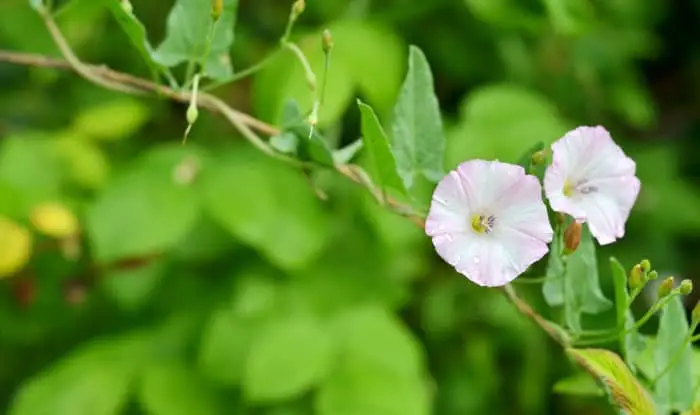
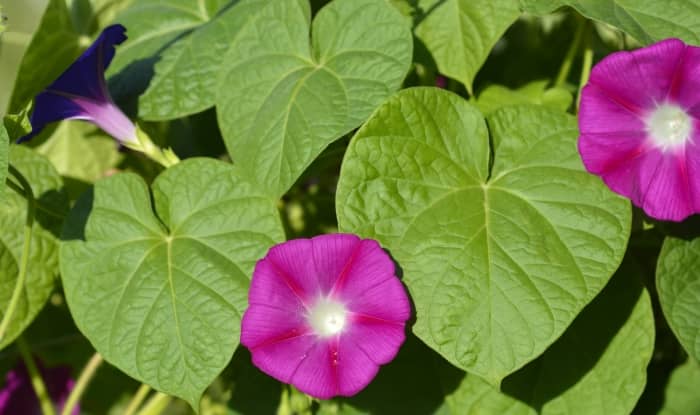


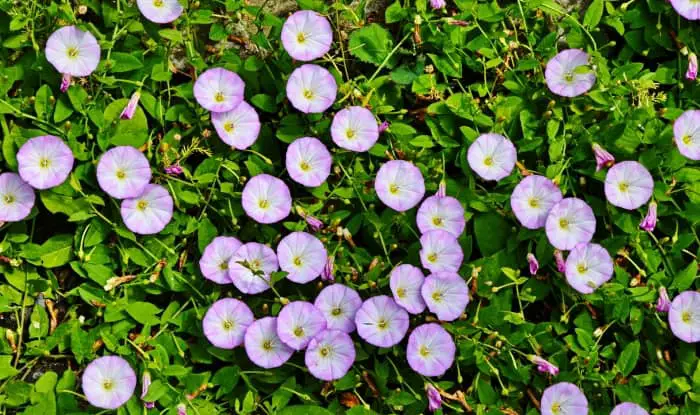
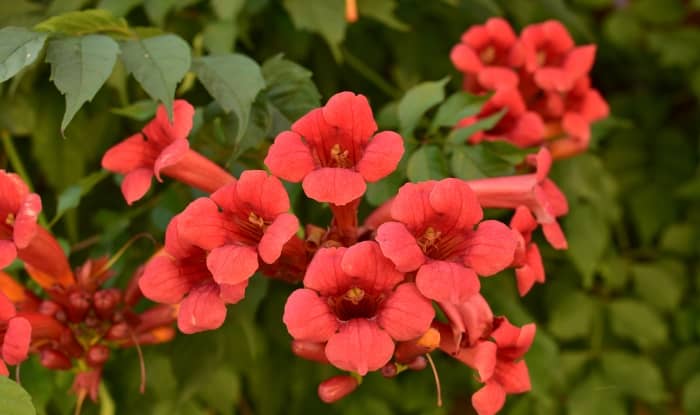

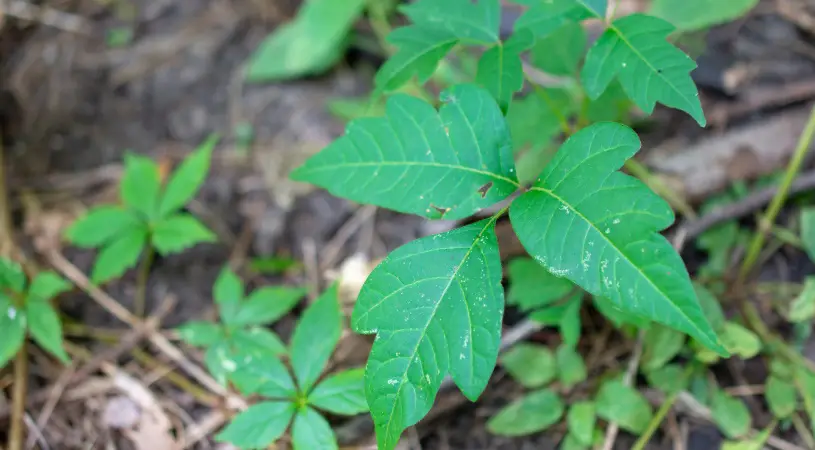
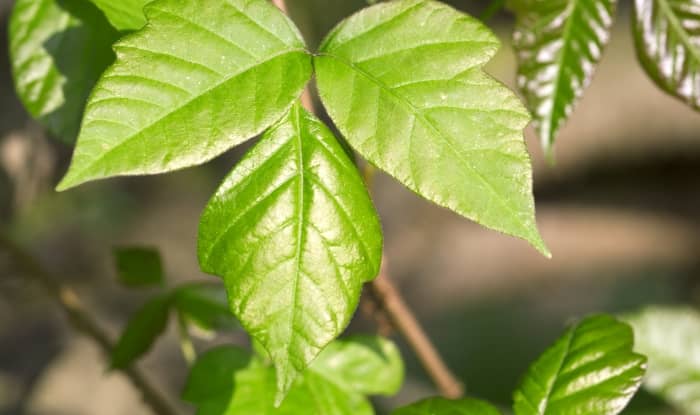

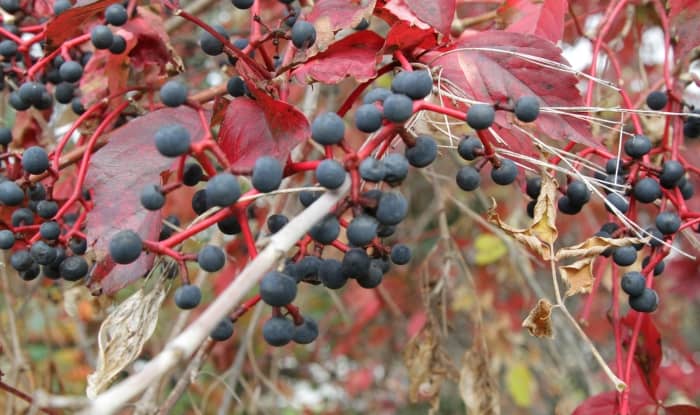
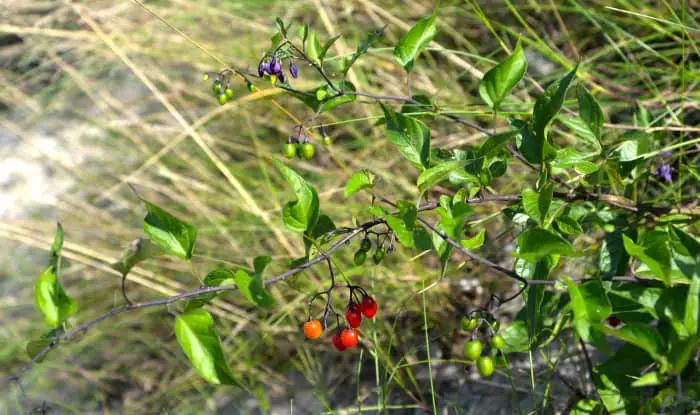
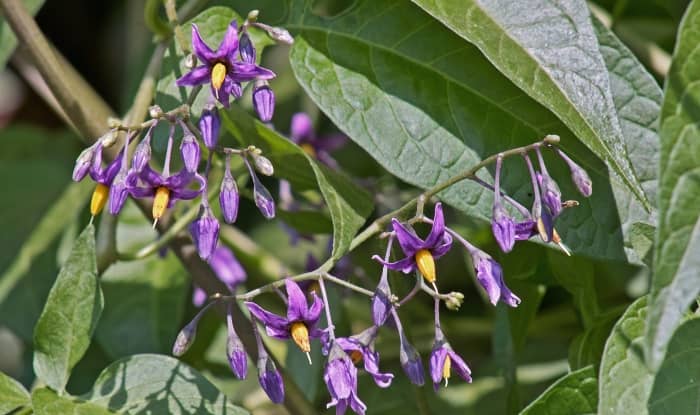
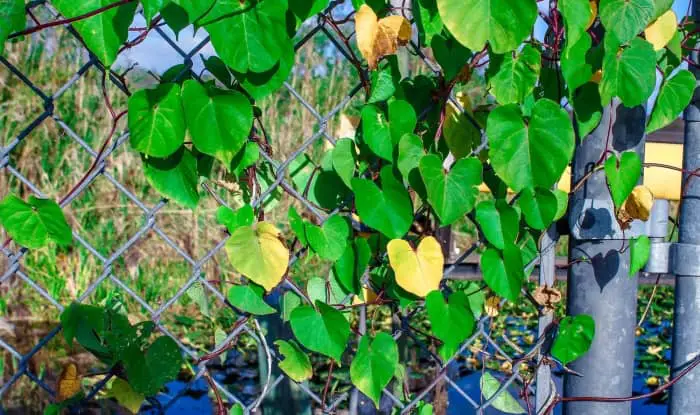
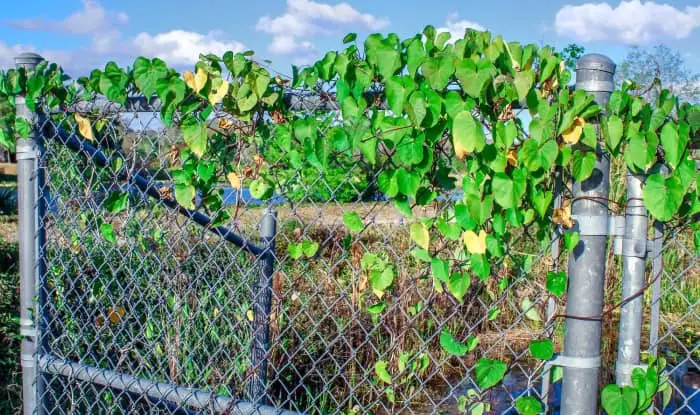
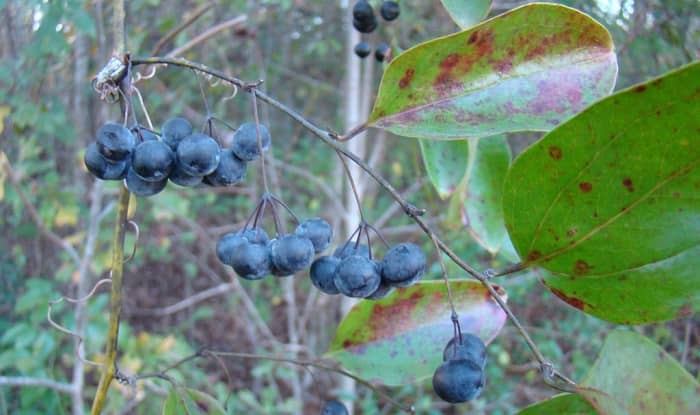
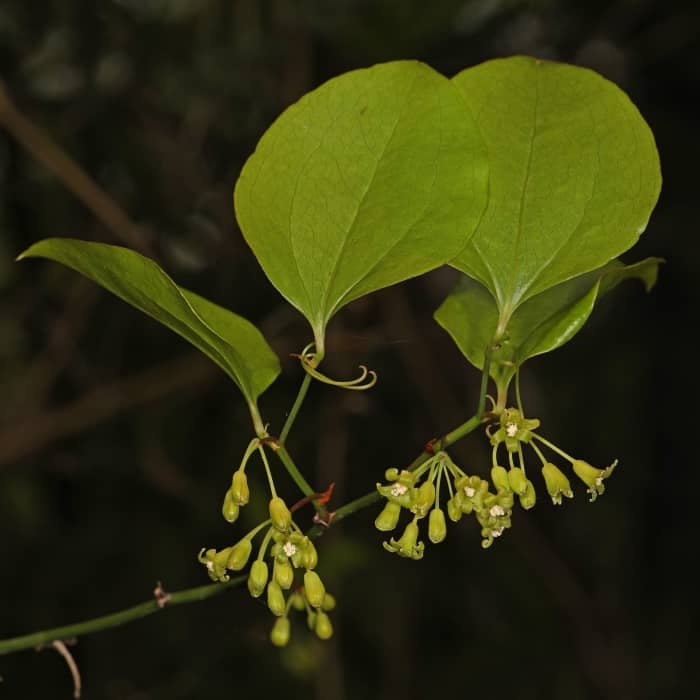
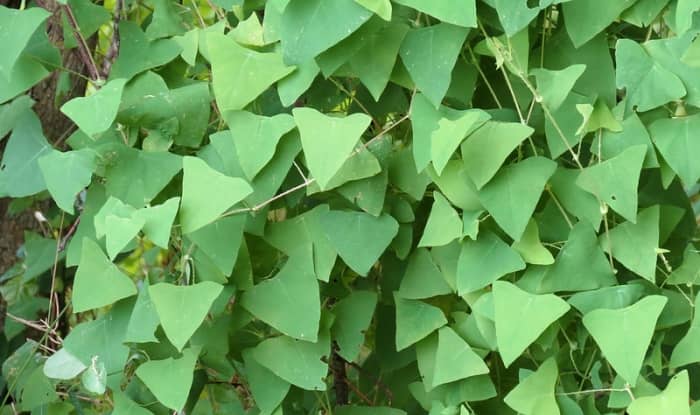
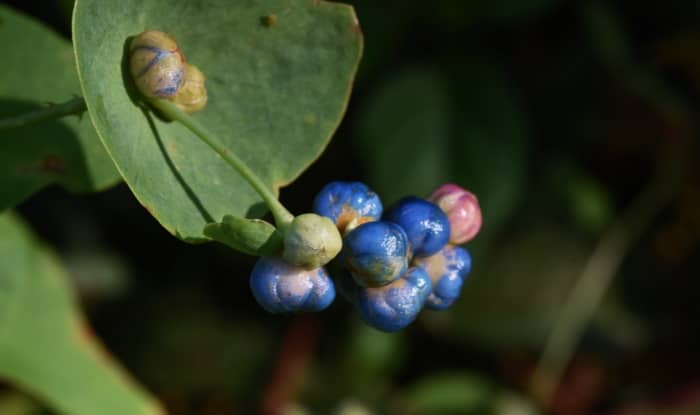
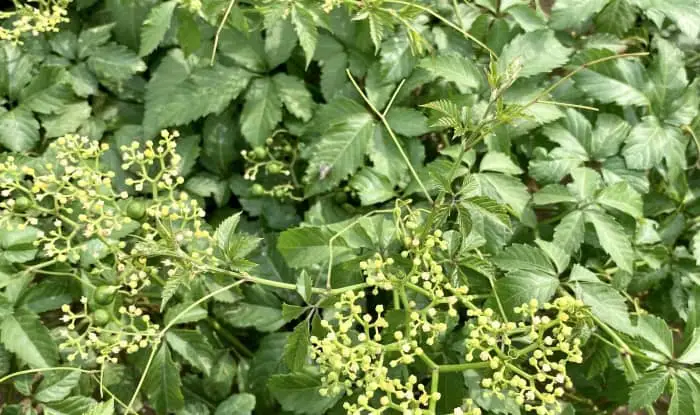
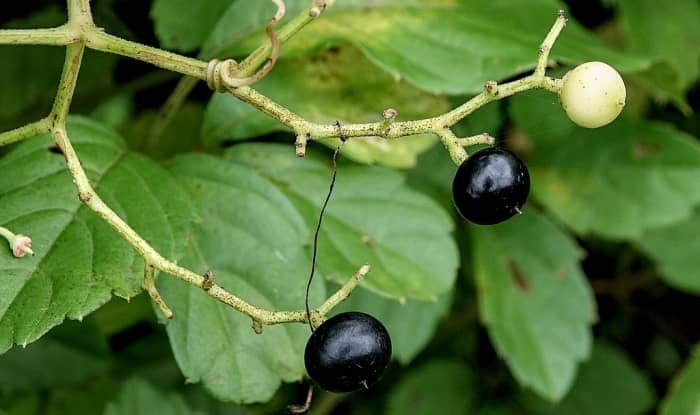
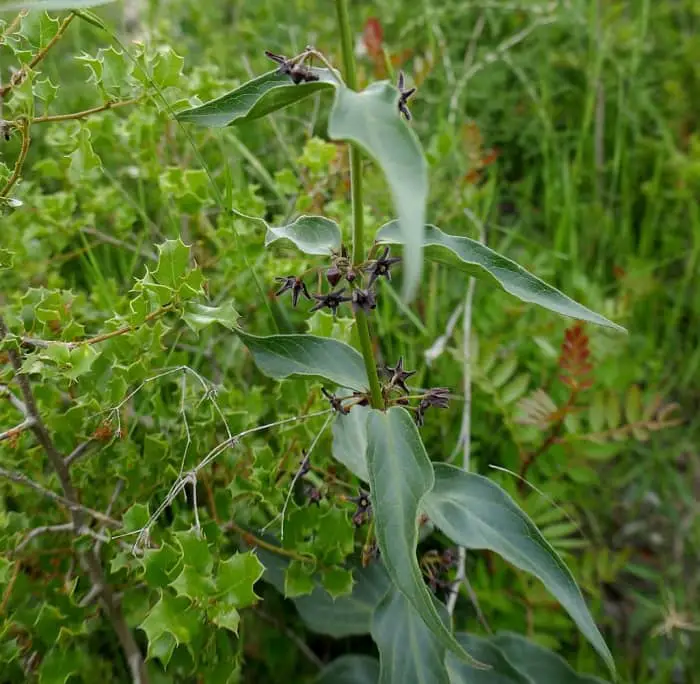

I saw no vine that looked like the one I am talking about. It has no flowers or berries of any kind. Rounded leaves and very thorny with a tap root.
Perhaps greenbriar.
dark green leafed vine that resembles watermelon vine with approximately 4 inch white flower that looks like a lily and when it dies a round spiky green ball appears. Beautiful flower and have never seen before. Just came up in yard after a storm.
Hi Emma, the large white flower and spiky seed capsule growing from a dark-green leafed vine could be Tropical white morning-glory/Moonflower vine (Ipomoea alba) or a related species, or maybe one of the Datura species that grow low along the ground like a vine such as Datura wrightii.
my vine is dead in November 15 with narrow pods about 3inches long. the pods are hanging on about 2in peduncles that have about 10 other nodes where no pods occured.
Hi, honeyvine is a host plant for monarch butterfly caterpillars and attracts lacewings as well. i have raised monarchs on this vine over the years including this past summer. if you must pull ot up look on the backs of leaves near the end of the vine to see if a single white butterfly egg has been laid there. if so, grow the vine in a glass of water and watch for a striped monarch caterpillar to hatch. i never ever destroy this annual vine. It isnt invasive and it attracts pollinators as well. Dies in fall. Leave it if you can
did not see the vine i was looking for thorns on the stem but none on leafs that look like maple leaves